by Eric Meier
When attempting to identify a wood sample, it’s important to keep in mind the limitations and obstacles that are present in our task. Before starting, please have a look at The Truth Behind Wood Identification to approach the task in a proper mindset; I consider the linked article to be required reading for all those visiting my site with the intent of identifying wood.
1. Confirm it is actually solid wood.
Before proceeding too much farther into the remaining steps, it’s first necessary to confirm that the material in question is actually a solid piece of wood, and not a man-made composite or piece of plastic made to imitate wood.
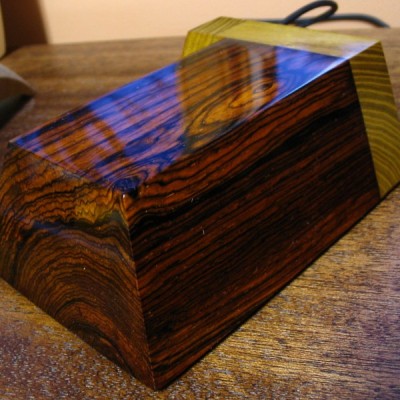
Can you see the end-grain?
Manufactured wood such as MDF, OSB, and particleboard all have a distinct look that is—in nearly all cases—easily distinguishable from the endgrain of real wood. Look for growth rings—formed by the yearly growth of a tree—which will be a dead-giveaway that the wood sample in question is a solid, genuine chunk of wood taken from a tree.
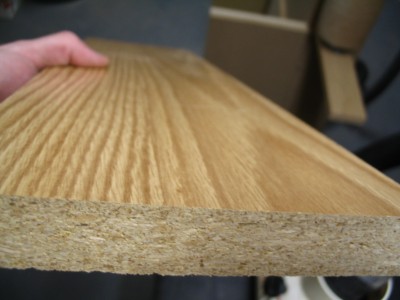
Is it veneered?
If you see a large panel that has a repeating grain pattern, it may be a veneer. In such cases, a very thin layer of real wood is peeled from a tree and attached to a substrate; sometimes the veneer can be one continuous repeating piece because it is rotary-sliced to shave off the veneer layer as the tree trunk is spun by machines. Assuming it is a real wood veneer with a distinct grain and texture—and not merely a piece of printed plastic—you may still be able to identify the outer veneer wood in question, but you should still realize that is it only a veneer and not a solid piece of wood.
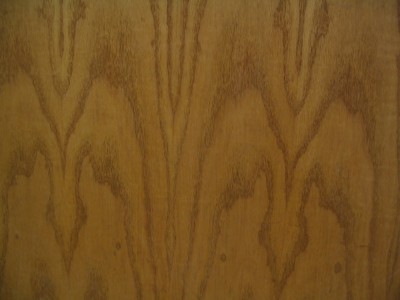
Is it painted or printed to look like wood?
Many times, especially on medium to large-sized flat panels for furniture, a piece of particleboard or MDF is either laminated with a piece of wood-colored plastic, or simply painted to look like wood grain. Many of today’s interior hardwood flooring planks are good examples of these pseudo-wood products: they are essentially a man-made material made of sawdust, glues, resins, and durable plastics.
2. Look at the color.
Some questions to immediately ask yourself:
Is the color of the wood natural, or is it stained?
If there is even a chance that the color isn’t natural, the odds are increased that the entire effort of identifying the wood will be in vain.
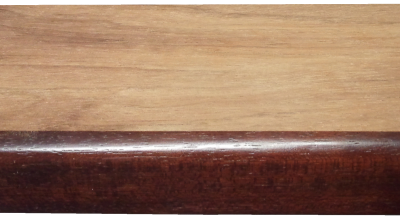
Is it weathered or have a patina?
Many woods, when left outside in the elements, tend to turn a bland gray color. Also, even interior wood also takes on a patina as it ages: some woods get darker, or redder, and some even get lighter or lose their color; but for the most part, wood tends to darken with age.
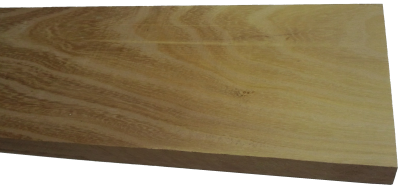
Is it possible to sand or plane the board to see the natural raw color of the wood?
The most predictable baseline to use when identifying wood is in a freshly sanded state. This eliminates the chances of a stain or natural aging skewing the color diagnosis of the wood.
3. Observe the wood grain.
If the wood is unfinished, then look at the texture of the grain. Ask yourself these questions:
Does the wood have an open, porous texture?
Most softwoods will be almost perfectly smooth with no grain indentations, while many common hardwoods have an open pore structure, such as oak or mahogany; though there are some hardwoods that are also smooth to the touch, such as maple.
Can you tell if the wood is quartersawn or plainsawn?
By observing the grain patterns, many times you can tell how the board was cut from the tree. Some wood species have dramatically different grain patterns from plainsawn to quartersawn surfaces. For instance, on their quartersawn surfaces, lacewood has large lace patterns, oak has flecks, and maple has the characteristic “butcher block” appearance.
Is there any figure or unusual characteristics, such as sapwood, curly or wild grain, burl/knots, etc.?
Some species of wood have figure that is much more common than in other species: for example, curly figure is fairly common in soft maple, and the curls are usually well-pronounced and close together. Yet when birch or cherry has a curly grain, it is more often much less pronounced, and the curls are spaced farther apart.
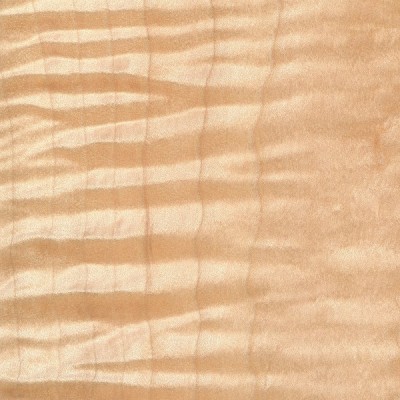
4. Consider the weight and hardness of the wood.
If it’s possible, pick the piece of wood up and get a sense of its weight, and compare it to other known wood species. Try gouging the edge with your fingernail to get a sense of its hardness. If you have a scale, you can take measurements of the length, width, and thickness of the wood, and combine them to find the density of the wood. This can be helpful to compare to other density readings found in the database. When examining the wood in question, compare it to other known wood species, and ask yourself these questions:
Is the wood dry?
Wood from freshly felled trees, or wood that has been stored in an extremely humid environment will have very high moisture contents. In some freshly sawn pieces, moisture could account for over half of the wood’s total weight! Likewise, wood that has been stored in extremely dry conditions of less than 25% relative humidity will most likely feel lighter than average.
How does the wood’s weight compare to other species?
Taking into account the size of the board, how does its weight compare to other benchmark woods? Is it heavier than oak? Is it lighter than pine? Look at the weight numbers for a few wood species that are close to yours, and get a ballpark estimate of its weight.
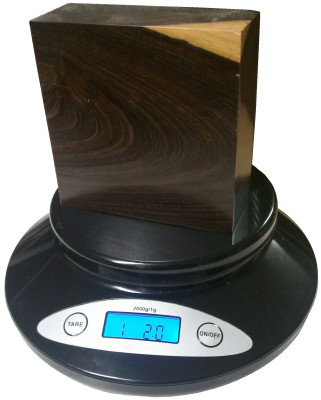
How hard is the wood?
Obviously softwoods will tend to be softer than hardwoods, but try to get a sense of how it compares to other known woods. Density and hardness are closely related, so if the wood is heavy, it will most likely be hard too. If the wood is a part of a finished item that you can’t adequately weigh, you might be able to test the hardness by gouging it in an inconspicuous area. Also, if it is used in a piece of furniture, such as a tabletop, a general idea of its hardness can be assessed by the number and depth of the gouges/dings in the piece given its age and use. A tabletop made of pine will have much deeper dents than a tabletop made of Oak. Additionally, you can always try the “fingernail test” as a rough hardness indicator: find a crisp edge of the wood, and with your fingernail try to push in as hard as you can and see if you’re able to make a dent in the wood.
5. Consider its history.
Many times we forget common sense and logic when attempting to identify wood. If you’ve got a piece of Amish furniture from Pennsylvania, chances are more likely that the wood will be made of something like black walnut or cherry, and not African wenge or jatoba. You might call it “wood profiling,” but sometimes it can pay to be a little prejudiced when it comes to wood identification. Some common-sense questions to ask yourself when trying to identify a piece of wood:
Where did it come from?
Knowing as much as you can about the source of the wood—even the smallest details—can be helpful. If the wood came from a wood pile or a lumber mill where all the pieces were from trees processed locally, then the potential species are immediately limited. If the wood came from a builder of antique furniture, or a boat-builder, or a trim carpenter: each of these occupations will tend to use certain species of woods much more often than others, making a logical guess much simpler.
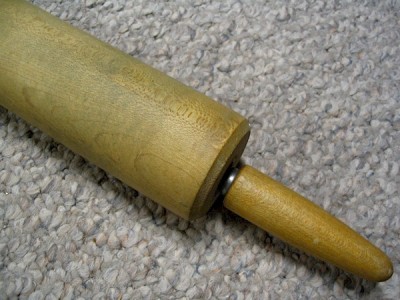
How old is it?
As with the wood’s source, its age will also help in identification purposes. Not only will it help to determine if the wood should have developed a natural patina, but it will also suggest certain species which were more prevalent at different times in history. For instance, many acoustic guitars made before the 1990s have featured Brazilian rosewood backs/sides, yet due to CITES restrictions placed upon that species, East Indian rosewood became a much more common species on newer guitars. (And this is a continuing shift as newer replacements are sought for rosewoods altogether.)
How large is the piece of wood?
Some species of trees are typically very small—some are even considered shrubs—while others get quite large. For instance, if you see a large panel or section of wood that’s entirely black, chances are it’s either painted, dyed, or stained: Gaboon ebony and related species are typically very small and very expensive.
What is the wood’s intended use?
Simply knowing what the wood was intended for—when considered in conjunction with where it came from and how old it is—can give you many clues to help identify it. In some applications, certain wood species are used much more frequently than others, so that you can make an educated guess as to the species of the wood based upon the application where it was used. For instance, in the United States: many older houses with solid hardwood floors have commonly used either red oak or hard maple; many antique furniture pieces have featured quartersawn white oak; many violins have spruce tops; many closet items used aromatic red cedar, and so forth. While it’s not a 100% guarantee, “profiling” the wood in question will help reduce the number of possible suspects, and aid in deducing the correct species.
6. Find the X-Factor.
Sometimes, after all the normal characteristics of a sample have been considered, the identity of the wood in question is still not apparent. In these instances—particularly in situations where a sample has been narrowed down to only a few possible remaining choices—it’s sometimes helpful to bring in specialized tests and other narrower means of identification.
The following techniques and recommendations don’t necessarily have a wide application in initially sorting out wood species and eliminating large swaths of wood species, but will most likely be of use only as a final step in special identification circumstances.
Odor
Believe it or not, freshly machined wood can have a very identifiable scent. When your eyes and hands can’t quite get a definitive answer, sometimes your nose can. Assuming there is no stain, finish, or preservative on or in the wood, quickly sand, saw, or otherwise machine a section of the wood in question, and take a whiff of the aroma.
Although new scents can be very difficult to express in words, many times the scent of an unknown wood may be similar to other known scents. For instance, rosewoods (Dalbergia spp.) are so named for their characteristic odor that is reminiscent of roses. Although difficult to directly communicate, with enough firsthand experience scents can become a memorable and powerful means of wood identification.
Fluorescence
While certain woods can appear basically identical to one another under normal lighting conditions, when exposed to certain wavelengths—such as those found in blacklights—the wood will absorb and emit light in a different (visible) wavelength. This phenomenon is known as fluorescence, and certain woods can be distinguished by the presence or absence of their fluorescent qualities. See the article Fluorescence: A Secret Weapon in Wood Identification for more information.
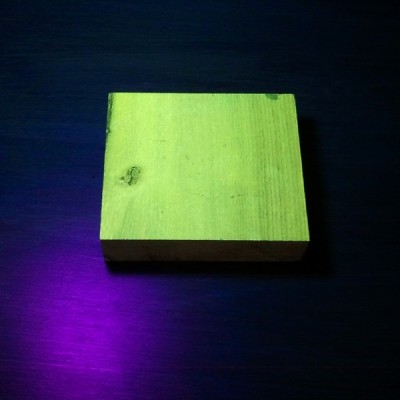
Chemical Testing
There are only a small number of chemical tests regularly used on wood, most of which are very specialized and were developed to help distinguish easily confused species with one another. They work by detecting differences in the composition of heartwood extractives. A chemical substance (called a reagent) is usually dissolved in water and applied to the wood surface: the surface is then observed for any type of chemical reaction (and accompanying color change) that may occur. Two of the most useful are the tests that are meant to separate Red and White Oak, and Red and Hard Maple.
Heartwood Extractives Leachability
Sometimes a wood species will have heartwood extractives that will be readily leachable in water and capable of conspicuously tinting a solution of water a specific color. For instance, the heartwood extractives contained in osage orange (Maclura pomifera) contain a yellowish-brown dye that is soluble in water. (This can sometimes be observed anecdotally when the wood is glued with a water-based adhesive: the glue’s squeeze-out is an unusually vibrant yellow.)
In a simple water extract color test, wood shavings are mixed with water in a vial, test tube, or other suitably small container, and the color of the water is observed after a few minutes. If the heartwood extractives are leachable by water, then a corresponding color change should quickly occur.
In addition to osage orange (Maclura pomifera), merbau (Intsia spp.), and rengas (Gluta spp. and Melanorrhoea spp.) are also noted for their readily leachable heartwood extractives. Because this property is quite uncommon, it can serve to quickly differentiate these woods from other lookalikes.
7. Look at the endgrain.
Perhaps no other technique for accurate identification of wood is as helpful and conclusive as the magnified examination of the endgrain. Frequently, it brings the identification process from a mostly intuitive, unscientific process into a predictable, repeatable, and reliable procedure.
Looking at the endgrain with a magnifier shouldn’t be a mystifying or esoteric art. In many cases, it’s nearly as simple as examining small newsprint under a magnifying glass. There are three components necessary to reap the full benefits contained in the endgrain:
I. A prepared surface.
When working with wood in most capacities, it becomes quickly apparent that endgrain surfaces are not nearly as cooperative or as easily worked as face grain surfaces. However, in this case, it is absolutely critical that a clear and refined endgrain surface is obtained.
For a quick glance of a softwood sample, a very sharp knife or razor blade can be used to take a fresh slice from the endgrain. However, in many denser species, especially in tropical hardwoods, one of the best ways to obtain a clear endgrain view is through diligent sanding. It’s usually best to begin with a relatively smooth saw cut (as from a fine-toothed miter saw blade) and proceed through the grits, starting at around 100, and working up to at least 220 or 320 grit, preferably higher for the cleanest view.
II. The right magnifier.
It need not be expensive, but whatever tool is used to view the endgrain should have adequate magnifying power. In most instances, 10x magnification is ideal, however, anything within the range of 8 to 15x magnification should be suitable for endgrain viewing. (Standard magnifying glasses are typically in the range of 2 to 4x magnification.)
These stronger magnifiers, sometimes called loupes, usually have a smaller viewing area than standard magnifying glasses. Fancier models—with built in lights, or larger viewing surfaces—are available at a premium; but the most basic models are usually only a few dollars.
III. A trained eye.
The third element that constitutes a proper endgrain examination is simply knowing what to look for. In analyzing the patterns, colors, shapes, and spacing of the various anatomical features, there is a veritable storehouse of information within the endgrain—all waiting to be unlocked. Yet, if these elements have not been pointed out and learned, the array of features will simply seem like an unintelligible jumble. The discipline of recognizing anatomical endgrain features is not easily summed up in a few sentences or even a few paragraphs, but it is nonetheless critical to the identification process. To this end, an in-depth look should be given to the various categories, divisions, and elements that constitute endgrain wood identification on the macroscopic level. (In this regard, macroscopic denotes what can be seen with a low-powered, 10x hand lens—without the aid of a microscope—rather than simply what can be seen with the naked eye.) Because the anatomy between softwoods and hardwoods is so divergent, each will be considered and examined separately:Still stumped?
If you have a mysterious piece of wood that you’d like identified, you’ve got a few options for next steps:USDA’s Forest Products Laboratory
You can mail your physical wood samples to the Center for Wood Anatomy Research.
Pros:
- Free
- Professional wood identification
Cons:
- Only available to US citizens
- Slow turnaround times (up to a month or more)
- Limited to three IDs per year
See their Wood ID Factsheet for more info.
Alden Identification Service
You can mail your physical wood samples (even small sections taken from antiques) to Alden Identification Service.
Pros:
- Professional wood identification
- Faster turnaround times (ranging from a few days to a week or two)
Cons:
- Paid service
See their ordering page for more info. (Note that Harry Alden has written several books while at USDA, including both Hardwoods and Softwoods of North America.)
Ask for help online
If the wood ID is merely a curiosity, or non-critical, you can post pictures of the wood in question.
Pros:
- Free
- No need to send physical samples
Cons:
- Greatly limited by the quality of the pictures provided
- Extra work usually required to get adequate clarity in photos
See article of Common US Hardwoods to help find the most commonly used woods.
Get the hard copy
 If you’re interested in getting all that makes The Wood Database unique distilled into a single, real-world resource, there’s the book that’s based on the website—the Amazon.com best-seller, WOOD! Identifying and Using Hundreds of Woods Worldwide. It contains many of the most popular articles found on this website, as well as hundreds of wood profiles—laid out with the same clarity and convenience of the website—packaged in a shop-friendly hardcover book.
If you’re interested in getting all that makes The Wood Database unique distilled into a single, real-world resource, there’s the book that’s based on the website—the Amazon.com best-seller, WOOD! Identifying and Using Hundreds of Woods Worldwide. It contains many of the most popular articles found on this website, as well as hundreds of wood profiles—laid out with the same clarity and convenience of the website—packaged in a shop-friendly hardcover book. 





Why I will no longer be replying to every wood ID request I’ve replied to literally thousands of wood ID requests on this site over the past 13+ years, but as the site’s popularity has grown, so has the time demands for ID on a daily basis. (Contrary to what some may seem to think, I am not some all-knowing wood wizard that can instantly ID your wood. It can actually take me a long time to sift through a lot of different resources.) Over the past few years, my backlog of pending wood species to be added to the… Read more »
Antique Farm Style Table
Assuming it is a dark stain. Guessing over 100 years old.
Right now, I do not have an end-grain picture, but grain is intriguing..?
Any Guesses ?
Thank You, in Advance, Eric !
Those ray flecks are very characteristic of quartersawn white oak. Hard to mistake it for anything else.
Impressive! You should have a donation link, I automatically thought, what q great help you are to so many people. Thank you for your time and expertise. You are full of great wood knowledge.
This was made in Japan can you tell what type of wood this might be? I read a lot of posts and tried to get a photo with the end grain as you had asked others. I hope this image works.
It looks most like mahogany to me. Not sure what type it would be from that distance. This article explains more: https://www.wood-database.com/wood-articles/mahogany-mixups-the-lowdown/
Hello I read your entire article with great interest. I am wondering what type of wood it is and what would be the best way to protect them from the elements. I am tempted to paint them in black and white laquer stripes but now that I see the nice wood I think I need to be more quaint with them. I am a recycler, upcycler when possible. Adopted these two Adirondack chairs in Vancouver Canada on a sidewalk. All the pieces are united with wood plugs. Only the big side panels are united with screws and bolts. They were… Read more »
Hi, I’m trying to match Wooden furniture that I bought a while back. Can anyone tell me what wood this is please?
Hi Eric,
I picked up this shallow bowl from Sri lanka. Trying to determine if this is some exotic wood or burl or if its some normal everyday wood. The last pic in the collage is of the outer side. The seller was not aware of what wood it is. Your website is put together beautifully but could not find anything similar.Request you to please identify and let me know if you can. Thanks!
That’s one of the weirdest things I’ve seen in the world of wood. Definitely not your everyday wood. I’d guess some type of burl, possibly a root burl.
Hello,
Your site is awesome. Could you confirm what wood you suspect the bookshelves and corresponding wood over the fireplace is? I have suspicion and would love your expert opinion! Thanks!
I can’t tell from that distance. But based on sheer stereotype and probability, I’m going to guess red oak.
I refinished our outside door, but noticed the area right below the glass ( I magnified part of the area) is now whiter. How I refinished it was just sanding it and putting Watco exterior wood finish on it. I would like to find out what happened to cause this and fix the problem. I think it is either walnut or Mahogany? Knowing this will help. Thanks.
Your door isn’t walnut or mahogany. It is a light-colored wood (probably oak) that was stained darker. You sanded through the stain. You need to strip the door, sand, re-stain, and refinish.
What type of wood is this could I use the doors for a counter top and use mineral oil on it??
Hi. It’s just sanded drawer. It’s very heavy. Any idea what type of wood it is please. Thank you
If I had to guess based on that one pic, I’d say it’s rubberwood that’s been stained, and (most) of the stain is now sanded off, but the lightest parts show the natural color of the wood.
Hi Eric, could you please help me identify the wood piece of furniture is made from. I’d like to protect it for the winter and I’m told I need to first figure out what wood it is before I make a mess of it. Thanks.
It looks quite weathered, but in decent shape. Can you get a closer shot of the grain, maybe in the wheel portion? I can’t make out any detail at that distance.
Hi Eric
I picked up some old Barn wood flooring. I realized that it is full of tar on one side. It’s from a really old barn. I want to make a reclaimed farmhouse table. Do you know if it’s softwood or hardwood? I’m sending a picture but I’ll get better pictures when I get home
Thanks
Carrie
This is a slab of unknown wood, which came out of an old barn, as the story is told. It was ugly gray, with years of dust & dirt ground into the surface. I had a refinisher finish the slab. It must be very hard because an attempt to plane the slab resulted in blade chatter marks. He had it belt sanded, removing an undetermined amount from top & bottom surfaces. He applied a 2-part epoxy. Amazingly surprised by the end results, would like to know what type of wood we have?
Looks like a spalted wood. Beech maybe?
that looks like a spalted wood ..caused by fungus its actually desirable if that’s what it is ?
Any idea what type of wood this is. It’s an antique high chair tray
Good morning everyone, I purchased some slabs this past weekend. I live in N.E. Ohio. Anyone have any clue what species this is? Thanks
Hello, can someone help identify this wood?
Is this oak?
It looks like a ring porous hardwood, so there’s a possibility it could be oak, but I can’t tell from the picture.
This is a front view
Hi I’m from Down under and always wanted to know about this piece of furniture
It has a lovely story, the drawers were used by a dairy farmer for his tools and they had a splash of white paint on them identifying what was in them. The rest was found thrown under a cypress tree in bits and pieces and has been lovingly restored.
I have a log that was cut down I was planning on making a bow out of it, but I wanted to know what it is first. It smells a little foul and gross. It is fibery but VERY hard. The cambium is slippery. I live in Colorado so that might give some insight. It is not a pine because when it was cut down it had a few small short leaves, maybe two inches long one inch wide. It has white inner bark, then an abrupt transition to brown.
Eric, any idea what this is? It’s a wall separating two terraces in a apartment building so it’s something weatherproof. No finish on it. I want to say teak but feel like it would be something less expensive… maybe ipe?
Hi Eric, great site, thank you! I’ve started selling older furniture pieces in the last year and am slowly working on my wood identification, so your site is a helpful resource! A lot of what I see I now know to be quartersawn white oak or mahogany, but this recent dresser is a stumper. It appears to perhaps be two different woods…or perhaps the same one, just stained differently! I love the soft swirling and striping in the drawer fronts. Ultimately, I’m hoping if I can give people info on the type of wood, they will be less likely to… Read more »
Hard to tell from that distance. Making an educated guess, I’ll say that that the drawer fronts are made from mahogany veneer (seen quite a bit on older pieces). Can’t tell what the rest is made of, perhaps they used a different species for the rest.
Hello,
Desperately needing help here…I ordered the attached from a custom furniture maker. It is sipposed to be made of reclaimed wormy chestnut. I have reclaimed wormy chestnut floors in my home. This piece looks to be made of fir or pine to me. Am I just wrong?
Can’t tell from that distance, though the darker stained growth rings would possibly suggest a ring porous hardwood over a softwood — and chestnut is a ring-porous hardwood…
https://www.youtube.com/watch?v=ExKj6uovn-M
Hi Eric,
Would you please help me identify this wood? It is a floor in a 1925 cottage in Florida.
More than likely it’s old growth southern yellow pine, sometimes called antique heart pine.
Maple? For sure a hardwood.
Is it really that yellow in person, or is your camera’s white balance off? If the color is correct, I don’t think it’s maple. Maybe movingui or some other type of satinwood-like wood. https://www.wood-database.com/wood-articles/sorting-out-satinwoods/
This is a very old small folding table. Can you tell me what kind of wood it is?
Hard to tell from that distance, but I’m going to guess the table is of high quality and premium veneers were used. I’d guess the primary center species would be Hondruan mahogany, and the edges may be some sort of satinwood-like veneer. https://www.wood-database.com/wood-articles/sorting-out-satinwoods/
Can you tell me any info on this wood
Would need a better picture, sorry!
Awesome write-up on your article about identifying different Woods. My mom and I are stumped as to what kind of wood her new chest of drawers is. Can you help?
Looks like it’s been veneered with some nice quartersawn material. My first guess would be quartersawn white oak.
Hey! Hope you can help. Bought an “antique” desk for my daughter. Started sanding the 4 layers of black paint and an oily substance began seeping through as soon as the top coat was removed. The other layers peeled right off. The table has now sat for over 48 hours and isn’t appearing to get any dryer. Any idea on type of wood and if this is normal. It should be noted, we are in humid, sunny South Florida! Thanks!!
Judging by the growth rings that are remaining dark (due to pigments being lodged in the large pores), it certainly appears to be a ring porous hardwood. My first guess would be oak. (And no, it’s not normal to have oily stuff seeping through the wood—it may be residual oil from a previous finish.) I’d keeping sanding till the finish is completely removed (as long as the table is solid wood and not veneer) and try to wipe it down down with a solvent like acetone or naphtha.
Any idea on what type of wood this may be? Driftwood? Petrified?
Looks to be Pecky Cyprus. I had a house in Florida years ago that all four walls in a Pool Room was that. Very pretty.
I wouldn’t even dare to identify the wood, but the holes are appear to be from ship worms.
Hello,
Based on the poor photos, are you able to please tell me the type of wood is used on this older, Skovby (brand) table? Table. Here is the top and below. Thank you!
Amy
I am an amateur woodcarver so I carve a lot of found wood. I found two logs of this wood along the side of the road after a tree came down and the city sawed it up to clear the road. They were about 16″ across and 18″ long. I think it is ash, but I am not positive on that. It sort of looks like ash but doesn’t really feel like ash. When it was green/wet, it was very heavy. After I sawed and split it down and it has cured some, it is extremely light now. Hard, but… Read more »
Ash seems like a reasonable guess. Would need to see a closeup of the endgrain to get a better chance at ID.
Hi Eric,
Thanks for your informative web site. I’m considering refinishing this dining room table. I’d like to know what type of wood I’m dealing with. It seems susceptible to dings so I’m guessing it’s not a hardwood. Its original “varnish” has become unmanageable. I believe its about 100 years old. I believe it was made in Massachusetts by a carpenter. Thank you….best,
kyle
HI Eric – I’m really struling to identify this furniture. I belive hey told me that it is a South American hardwood. It is incredibly heavy too – any help would be great – thanks (purely the table as know our stairs are Zebrano!)
Hard to tell from the picture. A closer shot of the endgrain might shed more clues.
Hi Eric, could you tell me what type of wood my lovely old console table is made of. I wonder if it needs treating in any way but wanted to check first. Many thanks
Possibly oak, stained a dark walnut color? Hard to say for sure from that distance.
Not sure why…. but my comment isn’t showing up from several days ago. I’d love to find out if this is some kind of hard wood or just plywood. Please help!
Can’t tell from the picture, sorry!
can you identify the wood type in the photo?
looks like my cypress table
Can anyone help me ID this 1920s Victorian farmhouse original wood floors. I think my refinisher has mis-identified and I want to make sure we know for sure before he gets to work.
Looks like an old-growth softwood such as yellow pine or douglas fir.
Can anyone offer information on “Appamat” timber?
Eric, thanks for a wonderful, comprehensive write up. I’ve looked in many places over the years and was lucky Google provided your article in the top hits. I will use this knowledge to hopefully identify by wood deck for which I paid for cedar when built 17 years ago but believe is pressure treated pine.
I’ve sanded a piece and took pictures in various lights and moisture levels. However, I will sand further. If I need some help, I may post again but wanted to make sure I thanked you.
Can anyone help me figure out what kind of wood this table base is made of?
I’m trying to identify this piece so I can decide if is good for spoon carving
This is front of a book that dates to 1580. From the UK. Is it possible to tell me what the wood may be.
This is the only picture I have.
Thanks
Hi , I’ve purchased some wooden flooring from a vendor who gets them from America. This is my new home in India. I’ve got 3000 sqft of these. He says yes genuine walnut of top grade… now I feel otherwise especially cause of the percentage of knots on it… will not knots also mean that they are weak and mak create a hole through it in the long run….
Thanks. Your website is very informative . Thanks for sharing all that knowledge acquired over time to newbies like us for free :)
Are these solid planks, or engineered (with the appearance of different layers when viewed from the side)? As long as there is a sub-floor below, I don’t think the strength and knots will be too much of a factor.
Hi, thanks for the quick response .. these are not engineered. End grains are visible like in a solid wood… is it walnut for sure? European or american walnut… isn’t walnut supposed to be dark close to chocolate to black?? . Thanks
From your current picture, I can’t tell “for sure.” You would need to post a closeup of the endgrain. Walnut color is highly variable in color, depending on growing conditions, etc. A lot of the walnut coming from Europe tends to be lighter in color — something that I would chalk up more to growing conditions rather than different species.
Trying to figure out what kind of wood this is. From a Missouri barn
Thanks, Lee
Looks like a ring porous hardwood. Can you clean up the endgrain a little more and take another picture? A face grain image would help too. I’m going to guess oak initially.
Hi Eric,
Can you please help me identify this wood?
Thanks.
Hello. Can someone please help me identify this wood?
Assuming that is the wood’s natural color, and those are solid pieces, I’d guess African blackwood. I don’t believe Diospyros ebonies get large enough to make a solid guitar back. But I also find it curious that there’s no sapwood — I would expect at least some sapwood even with the largest pieces of African blackwood. It may not be the wood’s natural color — either dyed or thermally/chemically modified in some way.
Thanks Eric.I thought it could be some ebony. Like you said with absolute no grain and no sap it is hard to believe if the color of the wood is natural. But, the supplier says it is African Blackwood and can provide CITES for it as well.
Can someone please identify this wood. Many thanks
Looks to be Maple burl
Or, perhaps, Carpathian Elm?
Howdy ! I’m trying to determine if these are pine or cedar boards. The stain I want to use can’t be used on cedar. Any input would be appreciated ! Cheers
Hi Eric, i read your whole write up to try work out which wood my dining table is likely made from, i must say you certainly know your timber, but i was left still wondering what my tables wood is likely to be, seem like quite a few factor to consider when making a determination. Im hoping you, or anyone who might read this post can possibly give me a definite or most likely type of wood this table is made of, im going to list it to sell soon and just thought if i knew the grain of wood,… Read more »
Can you get some closer shots, both of the endgrain portions and also the face grain? Can’t tell from the pics yet.
Can someone help me identify this? It is on a dining table top I am stripping black paint off of. The wood is still slightly damp in these photos. The wood also has a wavy like sheen looking at it from different angles. The bottom of the table has a “made in Malaysia” stamp on it. It was purchased at a nice furniture store.